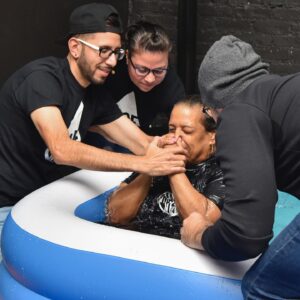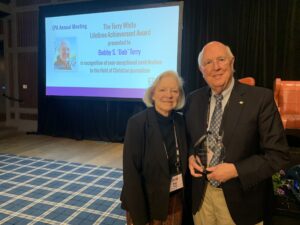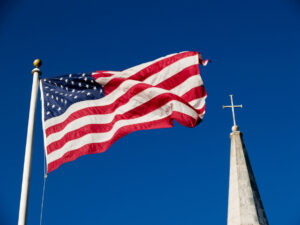
ALPHARETTA, Ga. (BP)–Shortly after being unanimously elected president by the North American Mission Board’s board of trustees, Geoff Hammond spoke with editors and reporters from a dozen state Baptist newspapers. Hammond responded to a broad range of questions including his vision for NAMB, his selection process, how he will relate to state conventions, his background as a missionary, and his views on the emerging/emergent church.
Hammond was joined by Bill Curtis, chairman of NAMB’s board of trustees, and Greg Faulls, chairman of the trustees’ president search committee.
A third-generation missionary with a soft British accent, the 49-year-old Hammond’s new post is effective immediately, though he will officially take over his new duties at the regular May 8-9 trustees meeting in Alpharetta. He was unanimously elected at a special called meeting of the board on March 21.
Following is an excerpt of many of the questions the state Baptist editors asked Hammond, Curtis and Faulls and their answers:
Q: Dr. Hammond, could you talk a little about your church planting experience?
Hammond: My first experience with church planting was at a large church in Harare, Zimbabwe. I studied church planting at Spurgeon College (London), worked at a mission with the First Baptist Church-Dallas, was a church planting missionary and professor in Brazil, and a director of missions and a church planter in northwest Arkansas. For some reason, God has blessed me to be involved in church planting on four continents throughout the world.
Q. Based on your role with the Southern Baptist Conservatives of Virginia convention, what is your thinking about openness when dealing with all Southern Baptists and across the political and philosophical spectrum? Is that your goal?
Hammond: The answer is an absolute yes! NAMB partners with all state conventions and I remind folks that my experience with Southern Baptists is from birth, in churches, on staffs, and representing all Baptists as both a NAMB and IMB missionary. I look forward to doing that as I have the privilege of leading NAMB.
Q. There was a motion at least year’s SBC annual meeting focusing on how NAMB and IMB can better partner with each other. Are there specific ways to do that?
Hammond: I’ve always believed there could be a closer relationship between IMB and NAMB. This is becoming even more obvious here in 2007 as the U.S. becomes more of a melting and mixing pot. For instance, there are so many things that IMB missionaries have discovered and introduced overseas that NAMB people can use as we reach ethnic groups and unreached people groups here in the United States.
Also, NAMB and IMB are working on joint projects like the recent People Groups website and data base. I know church planters who served IMB in Egypt, Asia and Latin America who are returning to the U.S. and bringing back their IMB experiences and ideas.
Q. Since you are there in the South in Virginia, what are your thoughts about the needs of missionaries and planters in places like the Dakotas and Montana, who are struggling with small churches in isolated places?
Hammond: Well, I do have a steep learning curve. Our people in the “pioneer” states have a difficult challenge. That’s why NAMB has to support them.
Q. Of all the challenges facing NAMB, what is the single greatest challenge you face?
Hammond: We must understand the huge potential we have with our partners to multiply our ministry. I see that as a positive thing. We must build relationships with local associations, state conventions and local churches –- with the person in the pew. We must tie the person in the pew back to our missionaries. And we must keep the NAMB story always out there.
Q. Dr. Hammond, the search process took a year and at NAMB you have a lot of interim labels on executive and other staff jobs. How do you plan to address that?
Hammond: Well, the Scripture tells us to be slow to speak and quick to hear. As I’ve told the trustees, I plan to do a lot of listening, looking and understanding before we make any significant decisions.
Q. Before your election, you were an executive in a state convention. What do you bring as a state executive to NAMB? What kind of advantage is this?
Hammond: Having sat on the other side of the table, I hope I’ll remember that side of the equation. My state convention in Virginia has had a good relationship with NAMB. Of course, there are areas where communications could be better from both sides. We at NAMB have to remember that state conventions are different and don’t all go about the work in the same way and don’t all relate to NAMB in the same way. I’m taking notes to bring to the table.
Q. How do you better understand the needs of church planters since you are one?
Hammond: Our church planters are our “special forces.” They’re on the front lines, out on the frontier. It’s tough. Church planting does not always go along a straight line. Sometimes they don’t see people saved every week and see more people in their churches. You go through hard times. I’ve told our church planters in Virginia that some of our best planters have come close to failure. I urge church planters to be learners in the field -– to keep in fellowship with other people. I would tell state associations and church planters that church planting networks are important for encouraging, equipping and mentoring planters so they don’t feel so isolated.
Q. What is the role of NAMB in church plants that are non-traditional and reject the Baptist label? How do you manage this and still succeed in the future?
Hammond: We want church planting to be creative but sound theologically. And as Southern Baptists, we are autonomous local churches but we cooperate on missions. We’re based on the Bible. The Baptist Faith & Message of 2000 holds us together. A church must feel it’s a part of the greater whole. There are a lot of folks who may look and be different, and express themselves differently in church life, but we’re all Southern Baptists.
Q. What is your view of the so-called emerging church movement and what should NAMB’s posture be toward emerging churches?
Hammond: I understand that it’s a new stream of influence in modern-day churches. What I’m grateful for is that at least they are wrestling with how to make the church relevant in modern-day society. There’s an article out in the most recent issue of Christianity Today that talks about five streams that flow in the emerging church and not all of them would we probably want to identify with as Southern Baptists. But some of them are asking ‘How do we reach post-moderns?’ This is going to be a continuing factor and will have influence on us in the years to come.
Curtis: At NAMB, our position in the past has been that while we certainly do not embrace all aspects of the emerging church movement –- and just getting the issues defined is a big problem –- there’s a place for NAMB to seek to exert influence and to encourage many of these young church planters on reaching culture but reaching it in such a way that will be faithful and consistent to where we are theologically. And there’s a tension there. We’re looking for opportunities to be an influence among our young pastors and planters as they seek to be culturally relevant. We are working diligently to navigate this area.
Q. Some of these churches that are defined as emerging churches use alcohol as a strategy, and set up shop in bars for theological discussions. Is that a strategy that NAMB embraces or rejects?
Curtis: Certainly there are some aspects of the emerging church movement that we are not comfortable with and this one is one of those. We’ve had a non-alcohol policy at NAMB for some time for our church planters and I don’t envision that changing.
Q. NAMB went through quite a crisis in leadership last year. How will you avoid that?
Hammond: I believe that integrity of Christian disciples can and must be guarded at all times. It takes a lifetime to build a reputation of integrity but that can be lost in a moment. I’m committed to accountability and transparency –- with me, what you see is what I am. Openness is important. I seek to understand before I know. That’s an important part of how I lead.
Q. Any final words, Dr. Hammond?
Hammond: I’d like to thank my fellow Southern Baptists for what they’ve done for me. They’ve embraced a guy who was born in a Southern Baptist mission hospital in Africa, sent to a Southern Baptist seminary, worked in SBC churches, and been a Southern Baptist missionary overseas. Some of the best folks I’ve ever met are Southern Baptists. They’re warm-hearted and generous.
Now I have this opportunity. This job is way bigger than me. I want to do it in God’s strength, in humility, and I thank Him for His grace in my life and the ways He’s led me. Now, I’ll lean on the Lord Jesus for support and guidance as we move into this next chapter of our lives.
Q. Dr. Curtis, talk about your tenure as board of trustees president over the past year.
Curtis: We have been through a challenging year as an agency. But it gave us the opportunity to re-focus on our vision and clarify the role of NAMB and what God has called us to do for these amazing folks called Southern Baptists. Through the search process and development of new policies at NAMB, God has grown the trustees together in amazing ways. Dr. Hammond’s unanimous election by the trustees is evidence of how far God has brought us.
Q. Dr. Curtis, what about the future relationship between the NAMB president and the board of trustees?
Curtis: Our board is absolutely committed to giving Dr. Hammond our wholehearted support. We have an authentic desire to come along side of him and entrust him with the position, and equip and enable him to succeed in what God has called him to do. Southern Baptists can have a great deal of confidence in the work of the board over the past year and in our commitment to follow Dr. Hammond as he leads us into the future.
Q. Dr. Faulls, could you discuss the degree of scrutiny the president search committee put Dr. Hammond under?
Faulls: As Dr. Hammond said, we had a very thorough search process. First, Dr. Hammond had to provide a resume. Then he had to fill out a questionnaire requiring a great deal of information; it was a pretty lengthy document. Then, because we were looking more for a missionary than a CEO, we put him through the same process our NAMB missionaries go through, the same paperwork and interviews. He then had a lengthy interview with the president search committee. He underwent a battery of psychological tests and assessment tests on management style, decision-making, accountability, resource allocation, HR allocation, leadership style, etc. Then we did the typical criminal background and credit checks. He passed with flying colors.
Dr. Hammond then did a face-to-face interview with the whole committee. In an exercise that took six weeks of preparation, he was asked to do a presentation on his vision of NAMB. It was when he gave this final presentation that we sensed that God had chosen him for the job.
–30–















